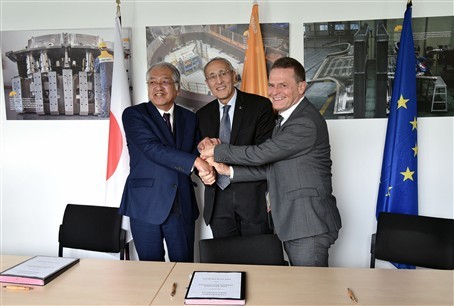EU-Japan fusion projects pave the way for ITER assembly and operation

(from left to right) Kenkichi Ushigusa, Director General of Rokkasho Fusion Institute, Bernard Bigot, ITER Director-General, Johannes Schwemmer, F4E Director
A trilateral arrangement for collaboration between IO and the Broader Approach (BA) projects – developed by F4E on behalf of Europe and QST on behalf of Japan – was signed in the margins of the ITER Council on 20 November 2019.
The main objective of the collaboration is for ITER to benefit from the knowledge and experience acquired by the development of the BA projects, and in particular the JT-60SA Satellite Tokamak, whose assembly and the commissioning of its individual sub-systems will be completed next spring, after which the final phases of integrated commissioning towards first plasma will be carried out. Participation and collaboration in the experience of starting the operation of a superconducting Tokamak would be highly valuable to the ITER Organization (IO) in view of the preparation and execution of ITER First Plasma and for improving the ITER Research Plan in the Pre-Fusion Power Operating phases. For Europe and Japan, the collaboration with the IO in the efficient implementation of ITER start-up and operation is of great interest and will also enable to train the next generation of researchers towards their participation and leadership in the ITER Project. Finally, this close cooperation will also benefit the development of a demonstration reactor after ITER. The collaboration is based on the exchange of data and information; exchange of scientists, engineers and other technical experts; exchange of equipment, materials and instrumentation; and jointly-performed experimentation, including remote participation.
Pietro Barabaschi, EU Project Manager for the BA projects underlines the importance of this collaboration agreement: “It will not only help ITER during its operation phases but also provide important knowledge to the ITER team in preparation of its own assembly and commissioning. We all know how challenging this will be and we all trust that the collaboration that will be built between the BA and the ITER teams in the frame of this agreement will greatly help to reduce technical risks in ITER.”
The Broader Approach agreement – signed by EU and Japan back in 2007 – aimed at complementing ITER in the efforts towards the development of fusion. It consists of a number of joint projects, the most important being the Satellite Tokamak JT-60SA, built in Naka. JT-60SA will soon be the largest tokamak in the world, later second only to ITER. Other projects include the engineering validation, design activities and a full-scale prototype of an acceleration to test new materials (IFMIF), the IFERC (International Fusion Energy Research Center), including the realisation and operation of a supercomputer, and the implementation of DEMO design and R&D activities. All of the projects have been implemented using in-kind provisions from QST in Japan and F4E in the EU, where in particular most was in turn carried out by European Voluntary Contributors: SCK/CEN (Belgium); CEA (France); KIT (Germany); ENEA, INFN, and Consorzio-RFX (Italy); and CIEMAT (Spain).